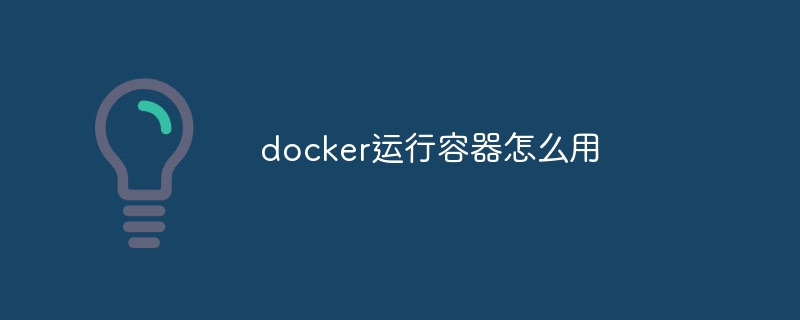How to use docker running container
To run a Docker container, you need to execute in turn: pull the image (docker pull
) create the container (docker run -it --rm --name
) interactive container (docker exec -it
/bin/bash) port mapping (docker run -it --rm --name my-nginx -p 8080:80 nginx) set environment variables (docker run -it --rm --name

How to run a Docker container
Running a Docker container involves the following steps:
1. Pull the mirror
First, you need to pull the required image. A mirror is an executable file containing applications, libraries, and dependencies. Use the following command to pull the image:
1 |
|
For example, to pull an Nginx image:
1 |
|
2. Create a container
After pulling the image, you can use the docker run command to create the container. This command allows specifying the running configuration of the container, such as port mapping and environment variables. Here is a basic example:
1 |
|
For example, to create a container named "my-nginx":
1 |
|
3. Interactive operation
After the container is created, you can enter the container using interactive mode. This allows execution of commands and viewing output within the container. Here are the commands to enter the container:
1 |
|
4. Port Mapping
If the container needs to expose the port to communicate with the outside world, port mapping is required. This can be done with the -p flag, which specifies the host port and container port. The following example maps port 80 in the container to port 8080 on the host:
1 |
|
5. Environment variables
Environment variables can be set when creating containers so that applications within the container can access them. Use the -e flag to specify the environment variable as follows:
1 |
|
6. Stop and delete containers
When the container is no longer needed, you can stop it using the docker stop command and then delete it using the docker rm command. The following example shows how to stop and delete the "my-nginx" container:
1 |
|
The above is the detailed content of How to use docker running container. For more information, please follow other related articles on the PHP Chinese website!

Hot AI Tools

Undresser.AI Undress
AI-powered app for creating realistic nude photos

AI Clothes Remover
Online AI tool for removing clothes from photos.

Undress AI Tool
Undress images for free

Clothoff.io
AI clothes remover

Video Face Swap
Swap faces in any video effortlessly with our completely free AI face swap tool!

Hot Article

Hot Tools

Notepad++7.3.1
Easy-to-use and free code editor

SublimeText3 Chinese version
Chinese version, very easy to use

Zend Studio 13.0.1
Powerful PHP integrated development environment

Dreamweaver CS6
Visual web development tools

SublimeText3 Mac version
God-level code editing software (SublimeText3)

Hot Topics
 How to exit the container by docker
Apr 15, 2025 pm 12:15 PM
How to exit the container by docker
Apr 15, 2025 pm 12:15 PM
Four ways to exit Docker container: Use Ctrl D in the container terminal Enter exit command in the container terminal Use docker stop <container_name> Command Use docker kill <container_name> command in the host terminal (force exit)
 How to copy files in docker to outside
Apr 15, 2025 pm 12:12 PM
How to copy files in docker to outside
Apr 15, 2025 pm 12:12 PM
Methods for copying files to external hosts in Docker: Use the docker cp command: Execute docker cp [Options] <Container Path> <Host Path>. Using data volumes: Create a directory on the host, and use the -v parameter to mount the directory into the container when creating the container to achieve bidirectional file synchronization.
 How to restart docker
Apr 15, 2025 pm 12:06 PM
How to restart docker
Apr 15, 2025 pm 12:06 PM
How to restart the Docker container: get the container ID (docker ps); stop the container (docker stop <container_id>); start the container (docker start <container_id>); verify that the restart is successful (docker ps). Other methods: Docker Compose (docker-compose restart) or Docker API (see Docker documentation).
 How to check the name of the docker container
Apr 15, 2025 pm 12:21 PM
How to check the name of the docker container
Apr 15, 2025 pm 12:21 PM
You can query the Docker container name by following the steps: List all containers (docker ps). Filter the container list (using the grep command). Gets the container name (located in the "NAMES" column).
 How to start mysql by docker
Apr 15, 2025 pm 12:09 PM
How to start mysql by docker
Apr 15, 2025 pm 12:09 PM
The process of starting MySQL in Docker consists of the following steps: Pull the MySQL image to create and start the container, set the root user password, and map the port verification connection Create the database and the user grants all permissions to the database
 How to start containers by docker
Apr 15, 2025 pm 12:27 PM
How to start containers by docker
Apr 15, 2025 pm 12:27 PM
Docker container startup steps: Pull the container image: Run "docker pull [mirror name]". Create a container: Use "docker create [options] [mirror name] [commands and parameters]". Start the container: Execute "docker start [Container name or ID]". Check container status: Verify that the container is running with "docker ps".
 How to update the image of docker
Apr 15, 2025 pm 12:03 PM
How to update the image of docker
Apr 15, 2025 pm 12:03 PM
The steps to update a Docker image are as follows: Pull the latest image tag New image Delete the old image for a specific tag (optional) Restart the container (if needed)
 How to create containers for docker
Apr 15, 2025 pm 12:18 PM
How to create containers for docker
Apr 15, 2025 pm 12:18 PM
Create a container in Docker: 1. Pull the image: docker pull [mirror name] 2. Create a container: docker run [Options] [mirror name] [Command] 3. Start the container: docker start [Container name]






